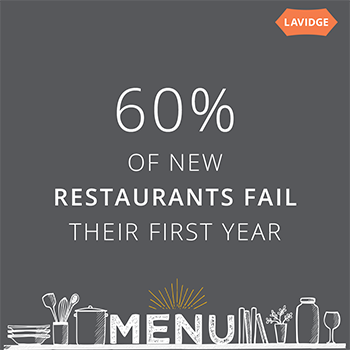Need fresh thinking? Help is a few keystrokes away.
8 Ways Research Can Help You Compete
“I have been up against tough competition all my life,” said Walt Disney. “I wouldn’t know how to get along without it.”
Exactly.
Some restaurants might prefer to own their busy intersection. But a strong competitor provides variety for your customers and helps increase awareness about the pleasures of dining out.
Still, you’d rather a consumer choose your restaurant, right? That’s why keeping an eye on your competitors is so important. The more information you have about the competition, the better you can respond, keep your customers and acquire new ones.
Here are eight things you should be doing to up your competitive IQ.
1. Identify your competitors.
All eating establishments don’t play in your space, so every restaurant business isn’t a competitor. If you’re operating a fast-food restaurant, don’t worry about the fine-dining place across the street. Instead, focus on the three or four similar style restaurants in your neighborhood. Don’t forget to consider the local supermarket; many have improved their made-to-order deli departments and some offer quality pre-made meals.
2. Eat there.
Don’t keep your competition at arm’s length. Dine at your main competitors every month. Try their newest fare and traditional favorites. Have the portion sizes changed? Does the food taste different? How does their menu compare to yours? Are they serving the food differently? In short, keep up with their latests restaurant concepts. Familiarize yourself with their brand identity.
3. Observe.
 Put on your Sherlock Holmes deerstalker hat and take notes. From the parking lot to in-store ambiance, consider how everything you see compares to your restaurant. Be sure to visit at different times (breakfast, lunch and dinner) to ensure you’re not missing any time-specific elements. Some things to look for include:
Put on your Sherlock Holmes deerstalker hat and take notes. From the parking lot to in-store ambiance, consider how everything you see compares to your restaurant. Be sure to visit at different times (breakfast, lunch and dinner) to ensure you’re not missing any time-specific elements. Some things to look for include:
- New signage and menus
- Remodeling of any kind
- Bathroom cleanliness
- New employee uniforms
- Price changes
- How many diners are there?
- Is their drive-thru busy?
- What type of signs or merchandising do they have displayed?
4. Look for ethnic outreach.
In the Southwest, Hispanic consumers represent a significant opportunity to gain market share. That’s why many restaurants are adding bilingual signage/menus and hiring employees who speak Spanish. And to attract consumers who want popular Southwest flavors and more options, some restaurants are adding ethnic foods and condiments to their branding strategy, such as guacamole and jalapeños, to help reshape their brand identity.
5. Size up their customer service.
This is usually where restaurants win or lose. You certainly want to provide excellent customer service to your clientele, but you also want to know how well your competitors are doing.
6. Getting fresh?
Find out if your competitors are adding menu items that emphasize fresh ingredients. More and more, consumers like having food choices made with fresh ingredients. So have something on hand and make sure it’s good, but don’t be surprised if few buy; it’s often the cost of doing business. Many consumers profess to wanting to eat healthier meals, but the numbers are small. A study by Johns Hopkins Bloomberg School of Public health found that most restaurants have added new menu items with 12% fewer calories.
7. Can food be customized?
The word choice might be overused, but it can be a competitive advantaged when offered at a restaurant. Many customers enjoy modifying their meals. According to Restaurant.org, one restaurant chain’s mobile ordering platform “resulted in a 25% higher average order size than phone orders.” One of the contributing reasons for this lift is that consumers are offered add-ons, extra toppings and side orders.
 8. Are they marketing?
8. Are they marketing?
Your time would be well spent investing your competitors’ marketing efforts. Pay attention to their footprint on social media, including Facebook, LinkedIn, Twitter and Instagram.
- How many followers do they have?
- Are they working with local influencers?
- What kind of offers are they promoting? Do they have a mobile app that allows online ordering?
- Do they have a loyalty program?
You should also try to find out if they are advertising on Yelp and making a concerted effort to gain online reviews. They may be marketing with fliers, direct mail or traditional media such as newspaper, TV, radio, paid digital ads or paid social. Some restaurants use a grassroots strategy to work their neighborhoods, such as delivering fliers and special offers to nearby businesses, and offering free catered meals to introduce people to their food.
Need help?
Not sure where to go from here? LAVIDGE has extensive experience in research. Our team can create a custom solution based on your restaurant's needs.
To learn more, give us a call at 480.998.2600 or send email to [email protected].
Why Restaurants Fail
According to a study by Ohio State University, 60% of new restaurants fail their first year. And 80% fold within five years. Those aren’t great odds.
Business Insider recently spoke with Restaurant: Impossible star and chef Robert Irvine.1 Here's his list of top reasons why most restaurants fail.
-
Inexperience: “Potential restaurateurs do not realize or appreciate the specific set of demands that come along with owning and running a restaurant. Once realized, it is often way too late.”
-
Bad people management: “The best managers are the ones who have worked their way up the chain of command and started at the bottom.”
-
Lack of accounting skills: Restaurant owners need to know “proper restaurant accounting procedures” and to “maintain and check the numbers you are generating to ensure they are up to date.”
-
Spotty customer service: “The way you handle your customers along every step of their dining experience (from being greeted at the door to paying the check) determines whether you will retain that customer.”
-
Sub-par food quality and execution: “Very slowly, your most popular dish can start to veer off its intended flavor profile and your cherished execution can stray from what is best for the end product.”
(Source: 1: Business Insider: Food Network Chef Robert Irvine)
2017 Southwest Food Service Marketing Report

This article is a brief abstract of our exclusive and authoritative study that takes the guesswork out of food service advertising and marketing. Rather than speculating about what will drive consumers to action, we've asked them.


